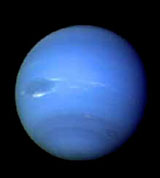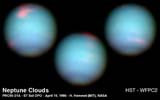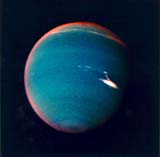
Introduction
Neptune is the fourth largest planet in the solar system. Despite being big,
it is invisible to the naked eye from Earth. Through a telescope, it looks like
a faintly bluish disk, the colour coming from
methane.
It has a diameter 3.9 times that of Earth (= 49,528 km), a mass of 17.1 Earth's
mass and a density of 1.64 g/cm3. It rotates once on
its axis in 16 hours 7 minutes.
Atmosphere
Neptune's atmosphere contains mostly molecular hydrogen and helium with about 3% of methane. Neptunian atmosphere has surface pressure of more than 100 bars. The atmosphere has winds of speed from 0 ms-1 to 200 ms-1.
Rings
From the Earth, we can see partial arcs surrounding the planet. Indeed, the presence of 4 dark rings is confirmed. Three of these rings are quite narrow, while the other is quite broad and diffuse.
Moons
Neptune has two large moons, namely Triton (shown on right) and Nereid. Six
smaller moons are also present. Another 4 moons are awaiting confirmation.
Triton, being the largest, has a large south polar
cap consisting of a slowly evaporating layer of nitrogen ice. Running
approximately parallel to the edge of the polar cap is a band of brighter white
material that is almost bluish in color.
Special Features - Great Dark Spot
Neptune had the Great Dark Spot (about the size of Earth), as shown on the right. However, the Great Dark Spot had disappeared in 1994.